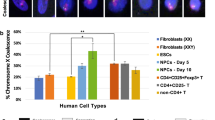Abstract
Scleroderma is a female-prevalent autoimmune disease of unclear etiology. Two fundamental gender differences, skewed X-chromosome inactivation (XCI) and pregnancy-related microchimerism, have been implicated in scleroderma. We investigated the XCI patterns of female scleroderma patients and the parental origin of the inactive X chromosome in those patients having skewed XCI patterns (>80%). In addition, we investigated whether a correlation exists between XCI patterns and microchimerism in a well-characterized cohort. About 195 female scleroderma patients and 160 female controls were analyzed for the androgen receptor locus to assess XCI patterns in the DNA extracted from peripheral blood cells. Skewed XCI was observed in 67 (44.9%) of 149 informative patients and in 10 of 124 healthy controls (8.0%) [odds ratio (OR) = 9.3 (95% confidence interval (CI) 4.3–20.6, P < 0.0001)]. Extremely skewed XCI (>90%) was present in 44 of 149 patients (29.5%) but only in 3 of 124 controls (2.4%; OR = 16.9; 95% CI 4.8–70.4, P < 0.0001). Parental origin of the inactive X chromosome was investigated for ten patients for whom maternal DNA was informative, and the inactive X chromosome was of maternal origin in eight patients and of paternal origin in two patients. Skewed XCI mosaicism could be considered as an important risk factor in scleroderma.
Similar content being viewed by others
References
Derk CT, Jimenez SA (2003) Systemic sclerosis: current views of its pathogenesis. Autoimmun Rev 2:181–191
Silman AJ, Hochberg MC (1993) Scleroderma. In: Silman AJ, Hochberg MC (eds) Epidemiology of the rheumatic diseases. Oxford University Press, Oxford, pp 192–219
Whitacre CC (2001) Sex differences in autoimmune disease. Nat Immun 2:777–780
Cutolo M, Capellino S, Sulli A, Serioli B, Secchi ME, Villaggio B, Straub RH (2006) Estrogens and autoimmune diseases. Ann N Y Acad Sci 1089:538–547
Mullinax F (1993) Chimerism and autoimmunity. In: Feng PH, Boey ML, Chang HH, Fong KY, Howe HS, Leong KH (eds) Proceedings of the 4th ASEAN Congress of Rehumatology. Communication Consultants, Singapore, pp 39–40
Kast RE (1977) Predominance of autoimmune and rheumatic diseases in females. J Rheumatol 4:288–292
Stewart JJ (1998) The female X-inactivation mosaic in systemic lupus erythematosus. Immunol Today 19:352–357
Nelson JL (1996) Maternal-fetal immunology and autoimmune diseases: is some autoimmune disease auto-alloimmune or allo-autoimmune? Arthritis Rheum 39:191–194
Mullinax F, Mullinax GL (1996) Pregnancy-induced scleroderma: identification of offspring-derived cells in patients with scleroderma [abstract]. Arthritis Rheum 39(Suppl 9):231
Nelson JL, Furst DE, Maloney S, Gooley T, Evans PC, Smith A (1998) Microchimerism and HLA-compatible relationships of pregnancy in scleroderma. Lancet 351:559–562
Artlett CM, Smith JB, Jimenez SA (1998) Identification of fetal DNA and cells in lesions from women with systemic sclerosis. N Engl J Med 321:1186–1191
Ozbalkan Z, Bagislar S, Kiraz S, Akyerli CB, Ozer HT, Yavuz S, Birlik AM, Calguneri M, Ozcelik T (2005) Skewed X chromosome inactivation in blood cells of women with scleroderma. Arthritis Rheum 52:1564–1570
Loubiere LS, Lambert NC, Madeleine MM, Porter AJ, Mullarkey ME, Pang JM, Galloway DA, Furst DE, Nelson JL (2005) HLA allelic variants encoding DR11 in diffuse and limited systemic sclerosis in Caucasian women. Rheumatology (Oxford) 44:318–322
Allen RC, Zoghbi HY, Moseley AB, Rosenblatt HM, Belmont JW (1992) Methylation of HpaII and HhaI sites near the polymorphic CAG repeat in the human androgen-receptor gene correlates with X chromosome inactivation. Am J Hum Genet 51:1229–1239
Busque L, Mio R, Mattioli J, Brais E, Brais N, Lalonde Y, Maragh M, Gilliland DG (1996) Non-random X-inactivation patterns in normal females: lyonization ratios vary with age. Blood 88:59–65
Sharp A, Robinson D, Jacobs P (2000) Age- and tissue-specific variation of X chromosome inactivation ratios in normal women. Hum Genet 107:343–349
Amos-Landgraf JM, Cottle A, Plenge RM, Friez M, Schwartz CE, Longshore J, Willard HF (2006) X chromosome inactivation patterns of 1,005 phenotypically unaffected females. Am J Hum Genet 79:493–499
Lambert NC, Erickson TD, Yan Z, Pang JM, Guthrie KA, Furst DE, Nelson JL (2004) Quantification of maternal microchimerism by HLA-specific real-time polymerase chain reaction: studies of healthy women and women with scleroderma. Arthritis Rheum 50:906–914
Ozcelik T (2007) X chromosome inactivation and female predisposition to autoimmunity. Clin Rev Alergy Immunol (in press)
Puck JM, Willard HF (1998) X inactivation in females with X-linked disease. N Engl J Med 338:325–328
Acknowledgements
We would like to thank Iclal Ozcelik for critical reading of the manuscript. Supported by grants from the Scientific and Technical Research Council of Turkey–TUBITAK-SBAG 3334, International Centre for Genetic Engineering and Biotechnology–ICGEB-CRP/TUR04-01, and Bilkent University Research Fund (to Dr. Ozcelik).
Author information
Authors and Affiliations
Corresponding author
Rights and permissions
About this article
Cite this article
Uz, E., Loubiere, L.S., Gadi, V.K. et al. Skewed X-Chromosome Inactivation in Scleroderma. Clinic Rev Allerg Immunol 34, 352–355 (2008). https://doi.org/10.1007/s12016-007-8044-z
Published:
Issue Date:
DOI: https://doi.org/10.1007/s12016-007-8044-z




